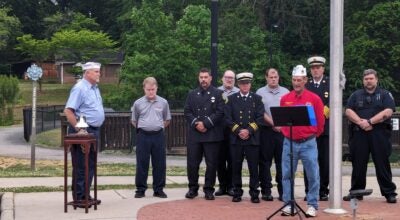Blues and Grays: Salisbury's Civil War sites
Published 12:00 am Monday, May 23, 2011
1. Old Rowan County Courthouse — 202 N. Main St. This 1854 building served as the county’s legal center until 1914. According to some historical accounts, the courthouse was spared from the torches associated with Gen. George Stoneman’s invasion thanks to pleas from fellow Masons.
2. St. Luke’s Episcopal Church — 131 W. Council St. Mrs. Jefferson (Varina) Davis, wife of the Confederacy’s president, and others from her dissolved Memphis, Tenn., church donated a silver communion set to St. Luke’s in 1888 as a memorial to a former rector who had once served in Memphis prior to retiring in Salisbury. The three-piece communion set, including a chalice, paten and flagon, is still used by the parish every week as part of its services. The parish dates back to 1753.
3. Freedman’s Cemetery and Soldiers Memorial AME Zion Church — corners of West Liberty and North Church streets. The cemetery was established as a burial ground for Salisbury’s African-American population, both enslaved and free. The granite wall separating it from the Old English Cemetery was erected in 1855. Over the years, portions of the cemetery were violated, bodies disinterred and all markers removed before memorial grounds were established and dedicated in 2006. Soldiers Memorial Church, founded in 1865, was first known as Salisbury Station and Mount Zion Society. The name later changed to honor Union soldiers who fought for the freedom of slaves.
4. Confederate Monument — in the median at Church and Innes streets. This memorial was dedicated May 10, 1909, and the dedication service included 162 Confederate veterans and Mrs. Stonewall Jackson. The United Daughters of the Confederacy erected the bronze grouping to honor the Confederate soldiers from Rowan County. The Frederick W. Ruckstuhl sculpture, made in Brussels and shown in Paris before arriving in the States, originally cost $10,000. Its restoration in 1990 cost $14,000. The soldier depicted in the grouping with Fame is based on a real person, Henry Howard Cooke of Tennessee, who later became a judge.
5. Josephus Hall House — 226 S. Jackson St. Dr. Hall was the first medical officer of the Confederate prison, serving from 1861 to 1865. He also served other hospitals in Salisbury. His pardon, signed by President Andrew Johnson, hangs on an upstairs wall of the home.
6. Gov. John W. Ellis House — 200 S. Ellis St. Ellis was governor when the state joined the Confederacy in 1861. He established his law practice in Salisbury in 1842, was elected to the N.C. General Assembly, was a Superior Court judge and was elected governor in 1858 and re-elected in 1860. Before the state seceded, he famously told President Lincoln that the Union would get no troops from North Carolina. The 41-year-old Ellis died in office only a few months after secession while in Red Springs, Va., where he was being treated for consumption. Ellis had lived with his widowed sister in this Greek Revival house, which she had built in 1850. He is buried in the Old English Cemetery, in the 200 block of North Church Street. The house is a private residence today.
7. Salisbury Confederate Prison and the Garrison House — 224 E. Bank St. The prison compound took in 16 acres and an abandoned cotton factory. A wooden stockade surrounded the prison, designed to accommodate 800 prisoners comfortably, but it was eventually forced to handle more than 12 times that number after the Union stopped the exchange of prisoners in August 1864. Thousands — estimates have varied greatly through the years, from 4,000 to 11,700 — died at the prison, which was abandoned two months before Stoneman’s arrival. Most historians today put the number of prison dead between 4,000 and 5,000. A two-story log house, previously owned by William Valentine, a free man of color, was located just outside the gates of the prison. It became known as the “garrison house” and is the only surviving structure associated with the prison complex.
8. Old Lutheran Cemetery — 500 block of North Lee Street. Confederates who died in Salisbury — as soldiers, prison guards, prisoners, “galvanized Yankees,” or as patients in the Wayside or Government hospitals — were buried in this cemetery, which was deeded to the German Lutheran Congregation in 1768. Ten different states are represented by the rows of markers in the northeastern section of cemetery. The cemetery also is the final resting place for Salisbury’s Col. Charles F. Fisher, who resigned his position as president of the N.C. Railroad to organize the 6th Regiment. A Yankee sharpshooter killed Fisher at the First Battle of Manassas. Fort Fisher in Morehead City is named for him.
9. Salisbury Arsenal — East Kerr Street at the railroad tracks. In 1856, Nathaniel Boyden and several others built the N.C. Foundry and Agricultural Machine Works on East Kerr Street. Early on, the foundry produced farming implements. But in April 1863, it became the Confederate Ordnance Works and produced shoes for horses and mules, bayonets, cannonball and other military equipment. A year later, the Confederacy renamed it the Salisbury Arsenal, and it employed about 240 people. Stoneman destroyed the arsenal on April 12, 1865.
10. Salisbury National Cemetery — at Military Avenue and Railroad Street. Those who died at the Confederate Prison were buried here. After October 1864, because of the large number of deaths, a mass burial system was employed, using numerous trenches, each about 240 feet long. The National Cemetery was established in 1870 and it contains three major monuments from Pennsylvania, Maine and the U.S. government.
View Civil War in Rowan – 150 Years Ago in a larger map




